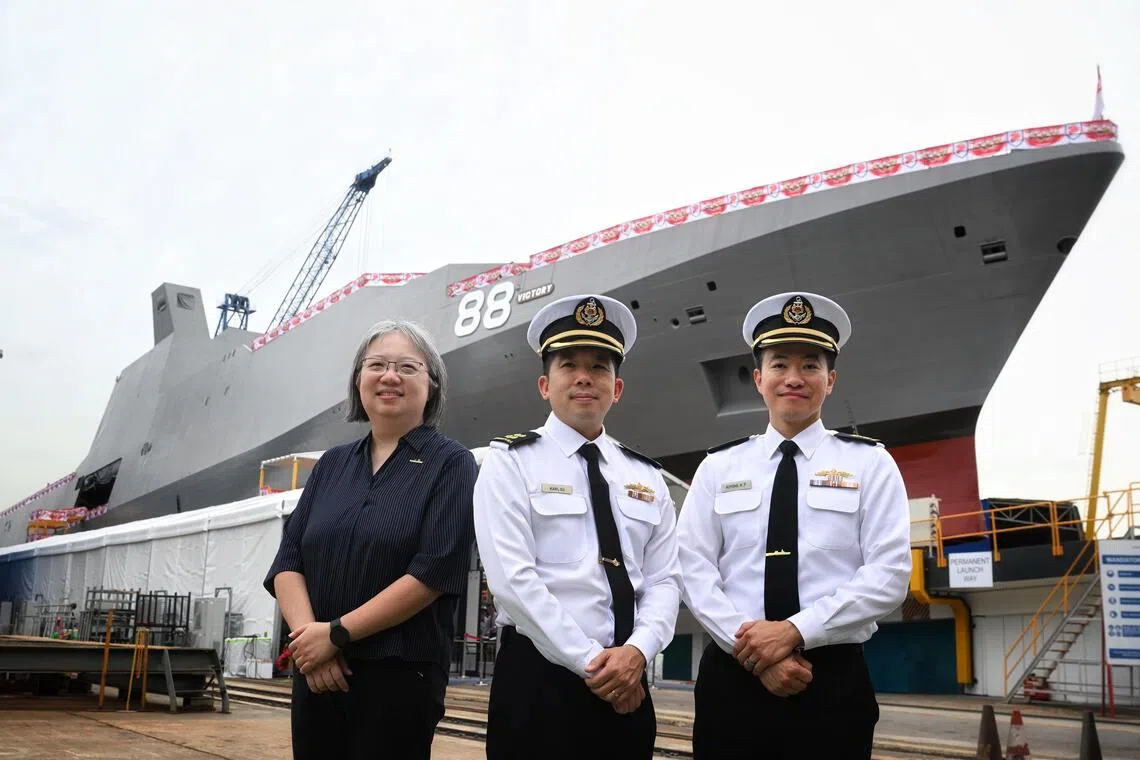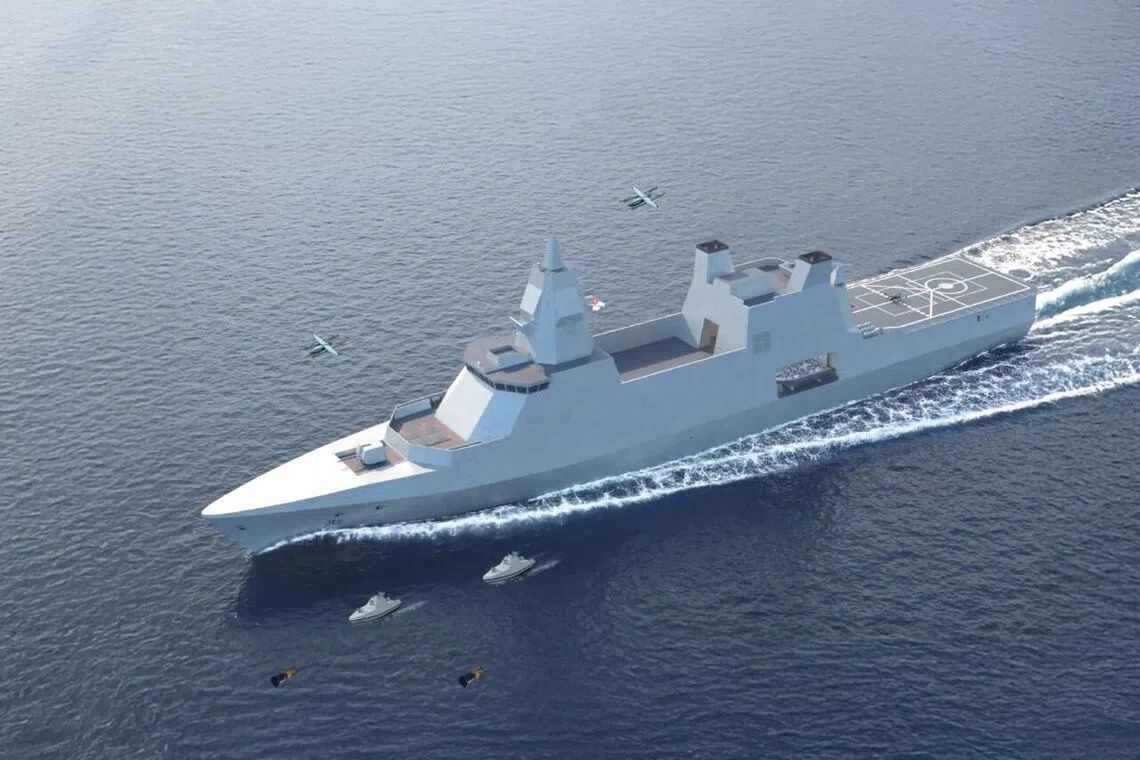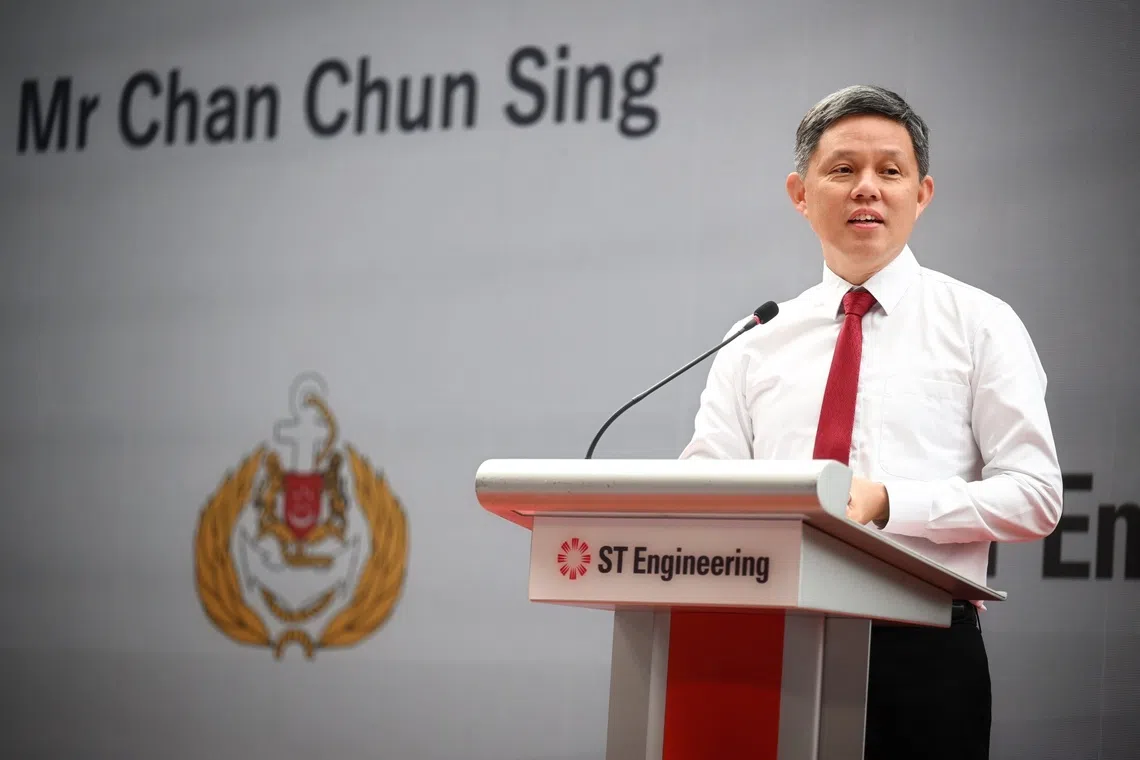‘Not a ship, but a mothership’: S’pore navy’s multi-role combat vessel offers new capabilities
Sign up now: Get ST's newsletters delivered to your inbox

(From left) Defence Science and Technology Agency’s senior programme manager (combat systems tech development) Tan Hui Ling, Lieutenant-Colonel Karl Su and Lieutenant-Colonel Auyong Kok Phai with MRCV Victory on Oct 21.
ST PHOTO: CHONG JUN LIANG
Follow topic:
- Singapore launched Victory, the first multi-role combat vessel (MRCV), replacing older ships and bringing flexible, advanced capabilities.
- The MRCV is designed as a modular "mothership" for unmanned systems with containerised modules for various missions like disaster relief.
- Defence Minister Chan said the MRCV can evolve with operational needs, integrating AI and networking for a "system of systems" fighting force.
AI generated
SINGAPORE - The Republic has launched the first of its new class of warships, designed to be highly configurable and integrated with a range of unmanned systems to carry out different mission types.
The first of Singapore’s fleet of multi-role combat vessels (MRCVs), named Victory, was launched on Oct 21 by Defence Minister Chan Chun Sing and his wife at ST Engineering’s Benoi Shipyard.
The MRCVs will progressively replace the Republic of Singapore Navy’s (RSN) ageing Victory-class missile corvettes from 2028, bringing a host of new capabilities to the table, including advanced sensors, weapon systems and network capabilities.
The vessel, which will be the RSN’s largest, combines the combat capabilities of a modern frigate with the capacity and control needed to be a mothership for a wide range of unmanned systems, said the Ministry of Defence.
With eight containerised modules in its mission bay, the MRCV is designed to be more flexible than its predecessor and able to quickly take on additional assets, such as shipping containers with medical facilities for humanitarian assistance and disaster relief missions.
Speaking at the launch ceremony, Mr Chan said Singapore’s security challenges going forward will only become more multifaceted, including the need to secure its strategic lines of communication – whether in the air, at sea, or in cyberspace.
That is why the MRCV is not built for a specific purpose to last for the next 20 to 30 years, he added. “I would dare say that no ship will be able to anticipate (the RSN’s) operational needs for the next 30 years.
“This is why this is not a ship, but it is a mothership that will bring together unmanned air capabilities, unmanned surface capabilities and unmanned subsurface capabilities. This is the new way that we have to operate and fight in the future.”
The Defence Minister gave the analogy of a mothership in sci-fi TV series Battlestar Galactica, integrated with artificial intelligence and an “evolving brain” able to both control the assets under its charge and network with a larger fighting force “so that we fight as a system of systems”.
Rather than having a complement of a fixed number of drones, the point is to be able to evolve the ship’s weapons systems and capabilities as requirements change, he added.
At the launch ceremony, ST Engineering chief executive Vincent Chong said the MRCV is the first of its kind in the world, combining an advanced warship and a mothership carrying unmanned capabilities, and will provide the RSN with “a significant leap in Singapore’s defence capabilities”.
Lieutenant-Colonel Auyong Kok Phai, who is deputy director (MRCV Project) from the RSN’s shipbuilding group, told the media that the MRCVs and their unmanned vehicles will expand the RSN’s surveillance area and extend its operational reach.
The new class of ships will be built in Singapore by ST Engineering. It was developed through a joint effort led by the Defence Science and Technology Agency, DSO National Laboratories and ST Engineering, together with international partners.
Swedish firm Saab Kockums is providing the vessels’ composite superstructures, and it also co-developed the MRCV’s basic design alongside Denmark’s Odense Maritime Technology.

The new class of ships will be built in Singapore by ST Engineering.
PHOTO: MINDEF
Following its launch, the MRCV Victory will undergo outfitting, platform and combat systems integration and acceptance trials.
The new class of vessels will be named Victory, Valour, Vigilance, Valiant, Vigour and Vengeance, retaining the names of the older missile corvettes as well as their pennant numbers.
This upholds the proud heritage and history of those ships, which similarly represented a quantum leap in the RSN’s capability when they entered service in the 1990s, said Mindef.
Apart from evolving its combat assets, Mr Chan said, the Singapore Armed Forces (SAF) also needs to ensure that its operating doctrines remain at the cutting edge, which requires its people to keep scanning the horizon.

Defence Minister Chan Chun Sing speaking at the launch ceremony on Oct 21.
ST PHOTO: CHONG JUN LIANG
By integrating operational concepts that are fit for purpose with up-to-date machinery, the SAF will then have capabilities that let Singapore stay ahead of threats, he added.
“This is what I hope our navy and our SAF will continue to do, even as we acquire new weapon systems,” he said.
The commanding officer (designate) of MRCV Victory, Lieutenant-Colonel Karl Su, said the MRCV is a “game-changing design” that will allow the RSN to sustain its operational posture, deterrence and relevance for years to come.
LTC Su described the MRCV as “a small city” with a power plant, data centre and a lot of flexible warehousing space on board.
This is the first ship in the RSN to have a common power system for both propulsion and ship services, with its power plant able to generate 30MW of electricity – enough to power over 50,000 HDB flats.
Given that this power is used mainly for the ship’s propulsion but also has to power the weapon systems and data centre on board, LTC Su said his crew will have to master the vessel’s operations.
“There’s no playbook for my crew to follow, and we’ll be developing this playbook from scratch,” he said.
“My priority as a (commanding officer) is to ensure my crew takes charge of mastering all the new systems, takes part across all ranks to contribute new ideas and their best ideas, to innovate and develop that new playbook for us.”

Correction note: This article has been updated for clarity.


